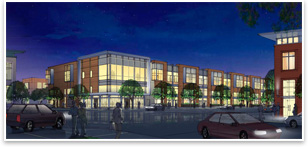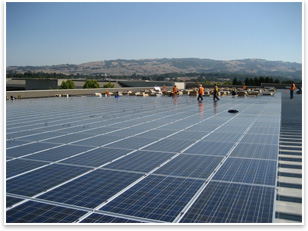
Multidiscipline Team Installs Largest Private PV Array in Calif. Summary: California’s largest private photovoltaic project has just been completed in Rohnert Park, a suburb of San Francisco, on the former Hewlett-Packard/Agilent Technologies campus. Dedicated on October 24, the 90,000-square-foot solar panel installation will generate 1.14 Megawatts and power the majority of the business center, which includes four large office buildings that are being renovated for reuse. The energy from the PV flat-mounted rooftop array is enough to completely power 750 homes during peak periods or 400 homes year-round. Below is a synopsis of the article. For the full text, click on the PDF link located in the column on the right.
The entire project has applied to be in the pilot program for LEED® for neighborhood development. According to Geof Syphers, Codding’s chief sustainability officer, the entire project has applied to be in the pilot program for LEED® for neighborhood development. LEED-ND was developed by the U.S. Green Building Council in coordination with the Congress for New Urbanism and the Natural Resources Defense Council. “We’ve been given some indication that we probably will be part of that pilot, so we’ll be one of the first projects to certify through LEED for neighborhood design,” says Syphers. “We have tried to think about this project in terms of four environmental concepts. The first is minimizing harm. That’s the first step: to use the materials, water, and energy efficiently; recycling job-site waste; reduce greenhouse gas emissions, and so on.
Making it livable To be a vibrant, healthy, diverse community, they are planning to build a wide range of home sizes and styles. Through walkability and sustainability “There hasn’t been a lot of clean building here,” according to Baker. “But I think more and more people are interested in that, and we expect it to be a bigger demand driver going forward. We’ve found that some companies have come just because they’ve heard what we’re doing [with making the campus sustainable]. All of them seem to appreciate the effort.” |
||
Copyright 2006 The American Institute of Architects. All rights reserved. Home Page |
||
news headlines
practice
business
design
recent related
› Santa Monica Park First to Receive LEED Silver Rating
› Tahoe Science Lab Goes for Platinum-LEED®
› New Sidwell Middle School a Living Component to D.C. Campus
Download the printer-friendly PDF version of this article.
SMV
Project Team
• Developer: Codding Enterprises, Inc.
• Landscaping Allen Land Design
• Civil Engineering and Habitat Consulting:Balance Hydrologics, Inc.
• Civil Engineers/Surveyors/Planners: BKF Engineers
Civil Surveyor: arlenzoli and Associates
• Homes Architecture: Farrell, Faber & Associates
• Urban Planner: Fisher and Hall Urban Design
• Green Building Consultants: KEMA Green
• Commercial Architecture: MBH Architects, Inc.
• Lofts/Condominiums/Apartments Architecture: Wix Architecture.



